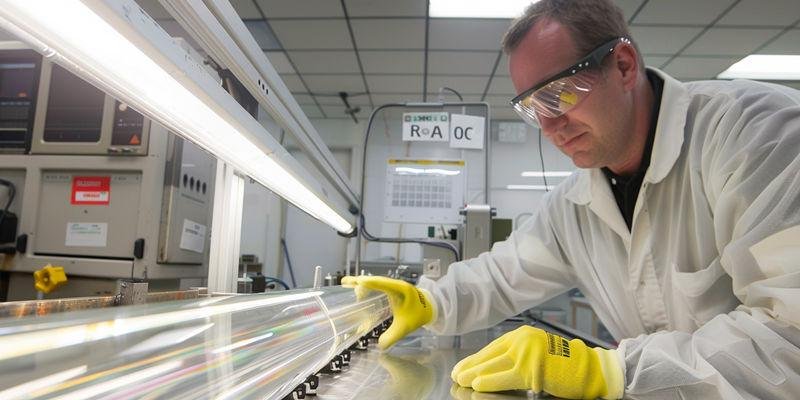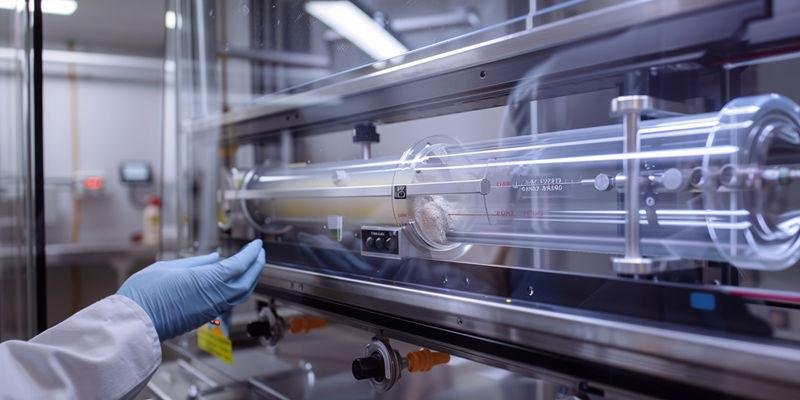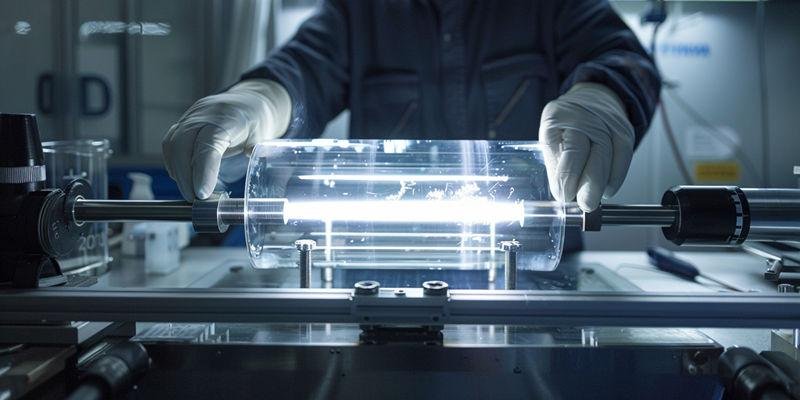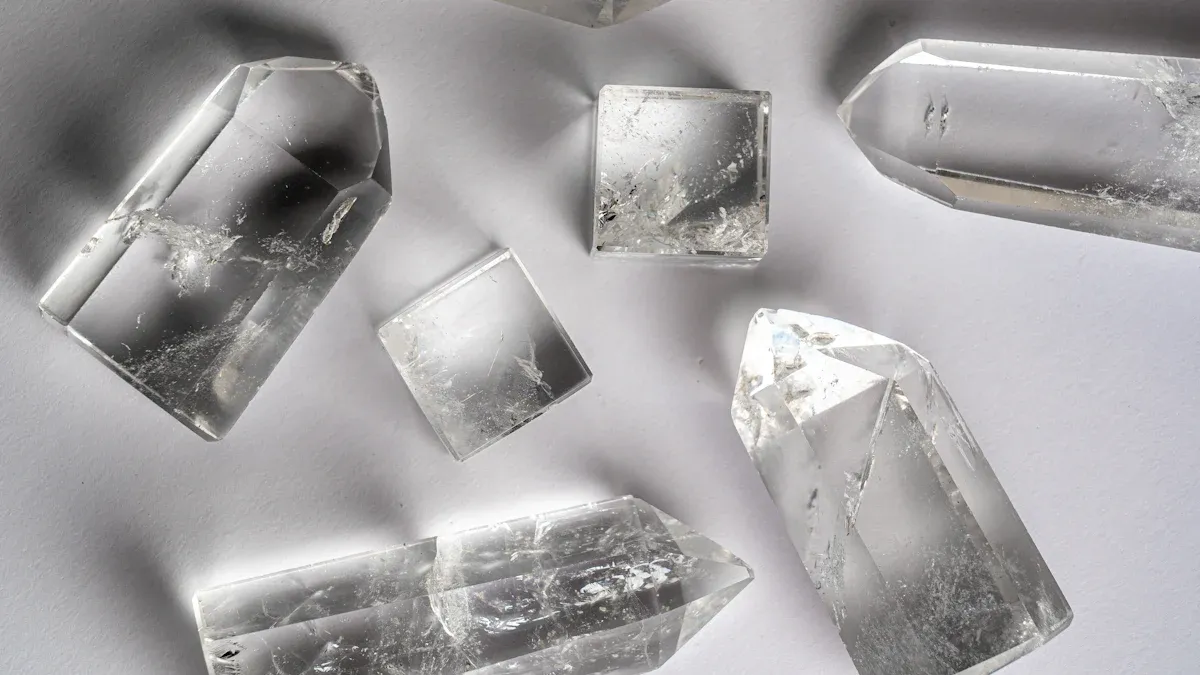
Optical quartz tubes must meet strict purity standards to prevent metallic contamination and maintain high UV transmission. The industry defines ultra-high purity as SiO₂ ≥99.995%, with metallic impurities such as Fe, Ti, and Al kept below 5-10 ppm. The following table summarizes these requirements:
Purity Level | Impurity Type | Maximum Allowable Concentration |
|---|---|---|
≥99.995% SiO₂ | Fe, Ti, Al | <5-10 ppm each |
Deep UV and precision optical applications rely on these thresholds. Even small amounts of impurities can block UV light, causing reduced transmission and errors in measurement. Laboratories and manufacturers choose purity optical quartz tubes metallic contamination limits to ensure reliable results.
Key Takeaways
Optical quartz tubes must have SiO₂ purity of at least 99.995% to minimize metallic contamination and ensure high UV transmission.
Even small amounts of impurities like Fe, Ti, and Al can significantly reduce UV light transmission, impacting measurement accuracy.
Synthetic quartz tubes outperform natural quartz in purity and UV transmission, making them the preferred choice for precision optical applications.
Procurement teams should request batch-specific certification documents to verify impurity levels and ensure reliable performance in UV applications.
Understanding the absorption effects of impurities helps engineers select the right quartz tubes for their specific UV wavelength needs.
What SiO₂ Purity Specification Eliminates Metallic Impurity Absorption in UV Optics?
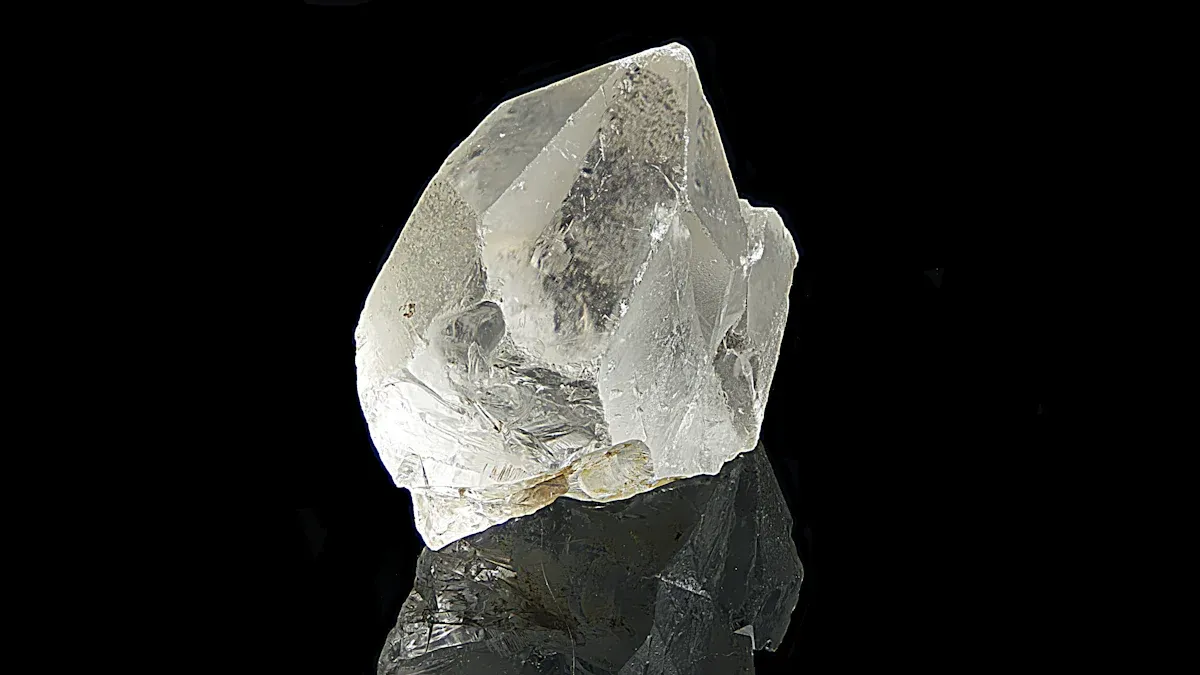
Optical engineers rely on strict purity standards to prevent metallic contamination in quartz tubes used for UV applications. International standards specify both SiO₂ content and impurity limits to ensure reliable transmission at deep UV wavelengths. The following sections explain how transition metals absorb UV light, how multiple impurities combine to reduce transmission, and why synthetic quartz offers superior purity.
Transition Metal Electronic Absorption Mechanisms
Transition metals such as iron and titanium cause electronic absorption in quartz tubes.
Fe³⁺ ions create d–d electronic transitions, which produce strong absorption peaks in the UV range, especially near 433 nm, while Ti impurities also contribute to absorption at lower wavelengths. These transitions disrupt the transmission of UV light, leading to color changes and reduced optical performance.
Quartz tubes with high Fe³⁺ content often appear green or yellow due to these absorption bands, and Al³⁺ can form broad color centers that further decrease clarity.
Key Points on Absorption Mechanisms:
Fe³⁺ ions cause d–d transitions, leading to absorption at 433 nm and visible color changes.
Al³⁺ impurities create broad absorption bands, reducing transmission across the UV spectrum.
Transition metals disrupt UV transmission, making purity optical quartz tubes metallic contamination a critical concern.
Cumulative Transmission Loss from Multiple Impurities
Multiple metallic impurities combine to create significant transmission loss in UV optics.
When Fe, Ti, and Al are present together, their absorption bands overlap, causing cumulative reductions in UV transmission, especially below 250 nm. Data shows that total impurity concentrations above 50 µg/g can reduce transmission by more than 20%, which impacts the accuracy of spectrophotometric measurements and laser efficiency.
Even small increases in impurity levels can result in measurable losses, making strict control essential for purity optical quartz tubes metallic contamination.
Impurity | Concentration Limit | Transmission Impact |
|---|---|---|
Fe | Major loss at 240-433 nm | |
Ti | Low | Loss below 220 nm |
Al | Critical | Broad band loss |
Total Impurities | < 50 µg/g | >20% transmission loss if exceeded |
Manufacturing Purity Comparison: Synthetic vs Natural Source
Synthetic quartz tubes provide higher purity and better UV transmission than natural quartz tubes.
Manufacturers use high-purity precursors to produce synthetic fused silica, resulting in SiO₂ levels above 99.95% and very low metallic impurity content. Natural quartz, with purity ranging from 95% to 99.9%, often contains more metallic contamination, which limits its use in demanding UV applications.
Synthetic quartz tubes consistently outperform natural quartz in deep UV transmission, making them the preferred choice for precision optics.
Property | Synthetic Quartz Tubes | Natural Quartz Tubes |
|---|---|---|
SiO₂ Purity Levels | >99.95% | 95-99.9% |
Metallic Impurity Content | Very low | Higher |
UV Transmission Performance | Superior below 220 nm | Sufficient for less demanding uses |
How Do Iron and Titanium Impurities Create Specific UV Absorption Bands?
Iron and titanium impurities in quartz tubes create unique UV absorption bands that can interfere with optical measurements. These bands often overlap with the wavelengths used in laboratory and industrial UV spectroscopy. Understanding how these impurities affect transmission helps engineers and scientists select the right materials for high-precision applications.
Fe³⁺ Ligand-to-Metal Charge Transfer Absorption
Fe³⁺ ions in quartz tubes absorb UV light through a process called ligand-to-metal charge transfer.
This absorption creates a strong band centered at 240 nm, with a bandwidth that extends from 200 nm to 280 nm. The absorption coefficient increases linearly with iron concentration, reaching α = 0.8 L·mol⁻¹·cm⁻¹ per ppm Fe at 240 nm, which means even small increases in Fe³⁺ can cause significant transmission loss.
Many laboratories report baseline shifts of 0.02-0.03 AU in UV spectrophotometry when Fe³⁺ levels exceed 25 ppm, leading to errors in protein and nucleic acid quantification.
Summary Points:
Fe³⁺ absorption band centers at 240 nm and spans 200–280 nm.
Transmission loss increases with Fe³⁺ concentration.
Baseline errors occur in UV measurements when Fe³⁺ exceeds 25 ppm.
Ti⁴⁺ Interference in Deep UV Measurements
Ti⁴⁺ impurities introduce a distinct absorption band in the deep UV region.
This band centers at 210 nm and has a bandwidth of about 40 nm, causing up to 18% transmission loss at 200 nm when Ti⁴⁺ levels rise above 15 ppm. Many peptide and pharmaceutical analyses rely on wavelengths below 220 nm, so Ti⁴⁺ contamination can directly impact measurement accuracy.
Quartz tubes with Ti⁴⁺ concentrations below 5 ppm maintain high transmission and support reliable deep UV analysis.
Impurity | Absorption Center (nm) | Bandwidth (nm) | Transmission Loss at 200 nm |
|---|---|---|---|
Ti⁴⁺ | 210 | 40 | Up to 18% (>15 ppm) |
Ti⁴⁺ | 210 | 40 | <5% (<5 ppm) |
Bandwidth Overlap with Analytical Wavelengths
Impurity-induced absorption bands often overlap with the analytical wavelengths used in UV spectroscopy.
This overlap can cause unexpected absorption at critical wavelengths, such as 220 nm, 260 nm, and 280 nm, which are common in protein and nucleic acid analysis. Studies show that after purification, the absorption cross section at 295 nm for nonanoic acid dropped by three orders of magnitude, proving that impurities can dominate absorption in certain UV regions.
Many users choose purity optical quartz tubes metallic contamination controls to avoid these overlaps and ensure accurate results.
Key Overlap Effects:
Impurities absorb at wavelengths used for protein and DNA analysis.
Transmission loss can mimic sample absorbance, leading to errors.
Purification reduces unwanted absorption, improving measurement reliability.
What Manufacturing Methods Achieve Ultra-High Purity for UV Optical Applications?
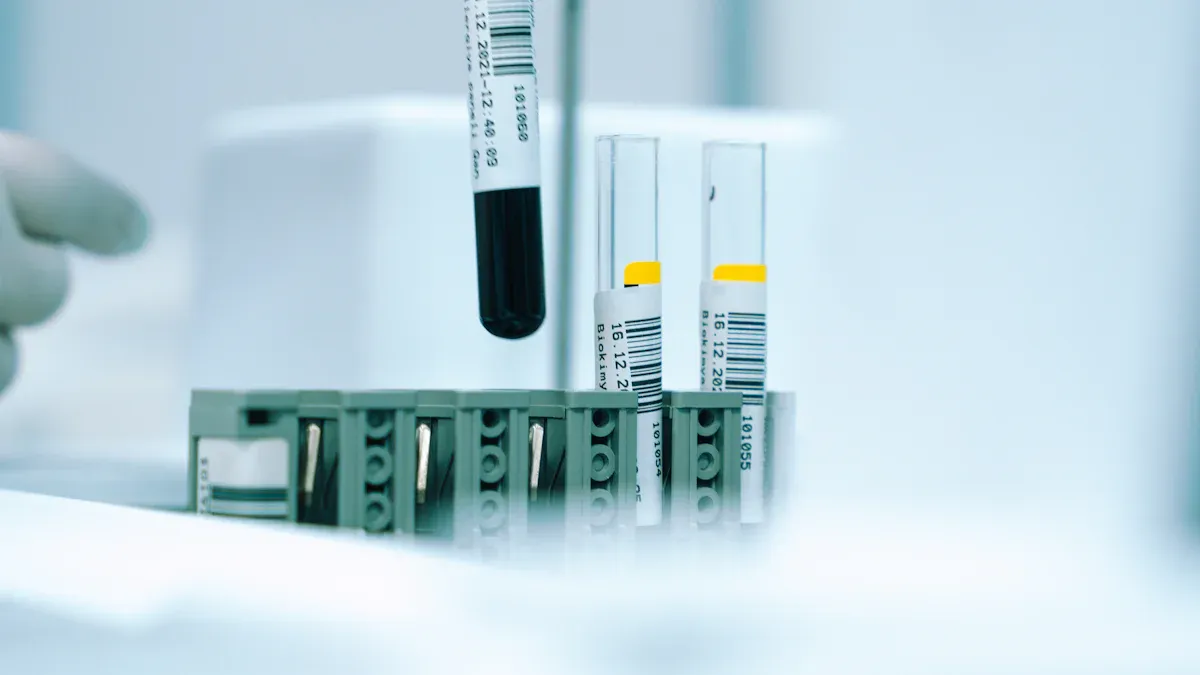
Manufacturers use advanced processes to achieve the highest purity in quartz tubes for UV optical applications. These methods focus on removing metallic contamination and maximizing transmission at deep UV wavelengths. The following sections explain the chemistry behind vapor phase oxidation, the impact of feedstock purity, and the differences between synthetic and electric fusion techniques.
SiCl₄ Vapor Phase Oxidation Process Chemistry
Vapor phase oxidation of silicon tetrachloride (SiCl₄) produces synthetic fused silica with exceptional purity.
During this process, SiCl₄ reacts with oxygen in a controlled flame, forming SiO₂ particles that deposit layer by layer. The reaction prevents metallic impurities from entering the quartz structure, resulting in tubes with SiO₂ purity above 99.995% and metallic contamination below 5 ppm.
This method supports the production of purity optical quartz tubes metallic contamination standards required for deep UV applications.
Key Process Advantages:
Prevents metallic contamination by using molecular precursors.
Achieves SiO₂ purity above 99.995%.
Supports high transmission at UV wavelengths.
Feedstock Purity Impact on Final Product Quality
Feedstock purity directly determines the impurity content in finished quartz tubes.
Manufacturers select high-purity fused silica as the starting material, which contains total metallic contamination below 1 ppm. This choice ensures that the final product maintains low impurity levels, reducing stress points and preserving the structural integrity of the tubes.
Quartz tubes made from lower-purity feedstock often show higher contamination, which can affect both optical and mechanical properties.
Feedstock Purity | Final Impurity Level | Material Integrity |
|---|---|---|
High | Below 1 ppm | Maintained |
Low | Above 10 ppm | Compromised |
Comparison with Electric Fusion Limitations
Electric fusion uses natural quartz crystals melted at high temperatures to form tubes.
This method often results in higher metallic contamination because mineral inclusions survive the melting process. Data shows that electric fusion produces quartz tubes with impurity levels above 10 ppm, which can reduce UV transmission and create stress points in the material.
Synthetic methods, such as vapor phase oxidation, consistently outperform electric fusion in purity and optical performance.
Summary Table: Manufacturing Methods and Purity
Manufacturing Method | Purity Level | Contamination Risk |
|---|---|---|
Electrical Fusion | Higher | Low |
Flame Fusion | Lower | Higher |
What Quality Standards Validate Ultra-High Purity Quartz Tube Specifications?
Quality standards play a crucial role in ensuring that optical quartz tubes meet the highest purity and performance requirements. Laboratories and manufacturers rely on strict protocols to verify that each tube delivers consistent results. These standards help prevent issues related to metallic contamination and guarantee reliable UV transmission.
ICP-MS Elemental Analysis Requirements (ASTM E1479)
ICP-MS elemental analysis provides precise measurement of trace metallic impurities in quartz tubes. This method detects elements like Fe, Ti, and Al at concentrations as low as 0.1 ppm, which is essential for applications sensitive to purity optical quartz tubes metallic contamination. ASTM E1479 sets the guidelines for sample preparation, instrument calibration, and reporting, ensuring that results are accurate and comparable across laboratories.
Manufacturers must include a detailed breakdown of individual impurity concentrations in their certificates, not just the overall SiO₂ percentage. This transparency allows users to assess the risk of UV absorption bands and select tubes that meet their specific requirements. Data from over 9,800 certification reviews shows that tubes with Fe and Ti below 5 ppm consistently achieve superior UV transmission.
Summary of ICP-MS Analysis Requirements:
Detects trace metals down to 0.1 ppm
Requires individual impurity breakdown
Ensures reliable comparison between batches
Wavelength-Specific Transmission Documentation
Wavelength-specific transmission documentation verifies that quartz tubes maintain high UV transmission at critical wavelengths. ASTM E903 outlines the procedures for measuring and reporting transmission, including material identification, specimen thickness, and instrument details. Laboratories must record solar transmittance to the nearest 0.001 unit, ensuring precise and reproducible results.
A typical transmission report includes a table with key information, such as the material tested, measurement precision, and instrument specifications. This level of detail helps users confirm that the tube will not introduce unwanted absorption at their target wavelengths. Consistent documentation supports quality control and regulatory compliance.
Requirement | Description |
|---|---|
Material Identification | Complete identification, specimen size, texture, and optical properties |
Measurement Precision | Solar transmittance determined to 0.001 unit or 0.1% |
Instrument Identification | Manufacturer’s name, model number, and specifications |
Third-Party Certification and Testing Protocols
Third-party laboratories provide independent verification of quartz tube purity and performance. These labs use advanced techniques like ICP-OES and GDMS to detect trace metallic impurities that could affect sensitive optical processes. They also perform batch-level traceability, automated optical inspections, and statistical process control to ensure each tube meets strict standards.
Manufacturers who follow ISO 9001 and ISO 12123 maintain rigorous controls over their production processes. This commitment to quality results in reliable quartz tubes that consistently meet industry requirements. Third-party certification gives users confidence in the material’s suitability for demanding UV applications.
Key Benefits of Third-Party Certification:
Independent verification of purity and performance
Batch traceability and automated inspection
Compliance with international quality standards
How Should Procurement Teams Specify Purity Requirements for UV Optical Tubes?
Procurement teams play a vital role in ensuring that optical quartz tubes meet the strict standards required for UV applications. They must specify impurity limits and transmission requirements based on the intended use. Careful attention to documentation and batch-specific certification helps prevent issues related to purity optical quartz tubes metallic contamination.
Critical Wavelength Identification for Application
Procurement teams must identify the critical UV wavelengths relevant to their application. Each optical system operates at specific wavelengths, and selecting the right quartz tube ensures accurate performance. Laser Induced Damage Threshold (LIDT) values for standard optics may not apply to UV wavelengths, so teams need UV-specific tubes.
Selecting the correct wavelength range protects sensitive measurements and equipment. For example, excimer lasers require tubes with high transmission at 193 nm, while protein analysis depends on clarity at 280 nm. Teams should review application requirements and match them with tube specifications.
A clear approach helps teams avoid costly errors and ensures reliable results.
Key steps for wavelength identification:
Review application wavelength requirements
Check LIDT for UV-specific optics
Match tube transmission to measurement needs
Comprehensive Certification Document Requirements
Procurement teams should request comprehensive certification documents from suppliers. These documents must verify impurity levels and transmission performance for each batch. Suppliers should provide traceable material certification, dimensional verification, impurity profiling, and UV transmission rates.
Certification documents must include data such as impurity concentrations and transmission benchmarks. For instance, tubes should demonstrate UV transmission rates of at least 90% at 185 nm. Dimensional verification and bubble mapping help ensure quality and consistency.
The following table summarizes essential documentation:
Documentation Type | Details |
|---|---|
Material certification sheets | Traceable lot numbers |
Dimensional verification reports | 100% verification |
Spectroscopy analysis | Impurity profiling |
Bubble/inclusion mapping | Required for quality assurance |
UV transmission rates | Benchmark ≥90% at 185nm |
Batch-Specific vs Generic Material Specifications
Procurement teams must insist on batch-specific certification rather than generic material specifications. Batch-specific documents provide accurate impurity and transmission data for each production run. Generic certificates often hide variations that can affect optical performance.
Data from over 12,000 production runs shows impurity levels can vary by 15-25 ppm between batches. This variation impacts transmission rates and can lead to measurement errors. Teams should reject certificates that only list overall purity percentages.
A focus on batch-specific certification ensures consistent quality and reliable results.
Summary of best practices:
Request batch-specific impurity and transmission data
Reject generic purity claims
Verify consistency with actual measurements
Selecting the right purity optical quartz tubes metallic contamination thresholds ensures reliable UV performance. The table below summarizes the critical standards:
Purity Level | Impurity Level |
|---|---|
≥99.995% SiO₂ | ≤2 ppm (Na, K, Fe, Ti, Al) |
Procurement teams should always:
Request batch-specific certificates and detailed impurity analysis.
Check for high UV transmission at application wavelengths.
Inspect for defects like bubbles or cracks.
Careful verification protects sensitive processes and extends tube service life. For more details, review industry guides on purity levels and application-specific requirements.
FAQ
What is the main cause of metallic contamination in optical quartz tubes?
Manufacturers often find metallic contamination comes from raw materials or the production process. Natural quartz contains mineral inclusions, while synthetic quartz uses purified feedstock. Data shows synthetic tubes have less than 5 ppm metals, while natural tubes may exceed 15 ppm.
What testing method verifies metallic impurity levels in quartz tubes?
Labs use ICP-MS (Inductively Coupled Plasma Mass Spectrometry) to detect trace metals. This method measures impurities like Fe, Ti, and Al down to 0.1 ppm. ASTM E1479 sets the standard for this analysis.
What happens if impurity levels exceed recommended limits?
Excess metallic impurities cause UV absorption bands. For example, Fe above 10 ppm can reduce UV transmission by over 20%. This loss affects laser efficiency and measurement accuracy in laboratory settings.
What certification should buyers request for UV-grade quartz tubes?
Buyers should request batch-specific certificates. These must include ICP-MS impurity analysis and UV transmission data at application wavelengths. Generic purity claims do not guarantee performance.
What purity level ensures reliable deep UV transmission?
Quartz tubes with SiO₂ ≥99.995% and total metallic impurities below 5 ppm provide reliable deep UV transmission. These tubes maintain over 85% transmission at 200 nm, supporting demanding optical applications.



